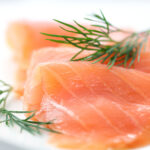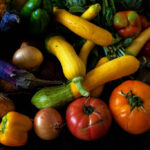Oy vay. What does “lox” mean? Once upon a time, in New York, in the 1920s, before Scottish smoked salmon—or any smoked salmon—became a big thing, barrels of fresh, unsmoked salmon in brine would be shipped from Alaska to the big metropolitan center. (Minus the Alaska part, salting salmon in barrels is how they did it in the Old Country). In New York, the Mittel European Jews who owned delis would remove the “lox” from the barrels (the name is taken from “lachs,” the German/Yiddish word for salmon), soak it for a few days to remove the extreme salty sting, and sell it. Jewish customers loved to slice their lox and put it on bagels with cream cheese—which made a nice, salt-negating counterpoint.
Some years later, a new idea from Nova Scotia, Canada was introduced to New York: cured salmon (just a tiny bit salty) that had been cold-smoked. To some of the former lox-lovers, this was an improvement—and salty, brine-cured, unsmoked, “true” lox began to fade away. Over time, “lox” and “Nova” became more and more like each other—and, to make things more confusing still, Nova stopped coming exclusively from Nova Scotia. If you walk into a New York “appetizing” store today, and if you’re given a choice between “lox” and “Nova,” you’ll see two whole sides of smoked salmon, and the two won’t be worlds apart: the lox will be a little saltier, the Nova will be milder and more elegant in texture. Get the “lox” only if you have cream cheese at the ready, if your doctor didn’t tell you to cut back on salt, and/or if you’re on some kind of nostalgia bender.
The following recipe is a throwback to the days when “lox” was brined salmon; I start with fresh salmon, and brine it myself. But this one isn’t quite as salty as lox used to be, so I prefer to call it “pickled lox.” I have added a bunch of seasonings that were not used back then, but I have resurrected the old idea of serving the pickled lox in a sour-cream-based sauce. Have you ever been tempted by herring in cream sauce, but don’t like the idea of herring? Some other day, we’ll talk about herring. For now, try this fabulous old-time dish: fresher-tasting, less fishy than herring, but brimming with the flavor of old New York.
Pickled “Lox” with Cream Sauce and Onions
makes 4-6 first-course servings
(Be aware that the salmon takes 4 days to pickle.)
4 cups water
1 cup white distilled vinegar
1 cup sugar
¼ cup kosher salt
6 bay leaves
2 teaspoons coriander seeds
2 teaspoons mustard seeds
1 teaspoon black peppercorns
½ teaspoon allspice berries
½ teaspoon dried dill
½ teaspoon celery seeds
½ teaspoon crushed red pepper flakes
1 pound skin-on salmon filet
1 large onion, peeled thinly sliced
1 cup sour cream
1. In a large saucepan, combine water, vinegar, sugar, salt, bay leaves and all spices (coriander through red pepper flakes); bring to a boil. Simmer 5 minutes to blend flavors, remove from heat and cool to room temperature.
2. Place salmon and onions in a non-reactive container (plastic or glass). Pour cooled brine over all. Refrigerate for 4 days.
3. To serve, remove salmon from the marinade. Remove skin from the salmon, and cut it into ¼” slices (my preference), or into 1″ cubes. Place the salmon in a bowl, and toss it with 1 cup of the sliced onions from the marinade (try to leave seeds behind.) Mix sour cream with 8 teaspoons of the pickling juice. Season to taste. Blend the salmon and onions in the bowl with the sour cream sauce. Divide among 4 appetizer plates and serve immediately.
Serving NOTE: The pickled lox is extremely versatile. You could, for example, leave out the cream sauce; simply slice the lox, and put it on a bagel with cream cheese. You could also put the cream-less lox slices on blini, with melted butter and sour cream. Or you could toss pieces of the lox in some sort of old-fangled/new-fangled salad (I vote for beets in the mix!) Once you add the cream sauce, there are still many new ways to go. I love this dish as is—but the inclusion of such things as capers and/or parsley would be great. How about adding thin slices of Granny Smith apple?
AND THE WINE…
I’m dreaming of a perfect cut-through wine for this dish: something light, graceful, brimming with electric acid, subtle enough to let the flavors of the salmon and the spices take center stage. Chablis…particularly Petit Chablis…to the rescue!
2013 Domaine Philippe Goulley Petit Chablis AOC (organic)
Wonderful Petit Chablis for food, very flexible. Light green in the glass. On the nose, it’s actually on the ripe side of young appley fruit. Absolute tingle in the mouth: light, evanescent, delicate, crackling with electric lemony acidity. A great oyster wine, a great cured salmon wine. And, according to the good folks at Martha Stewart, an “amazing” pick for a spring white wine! Also, for more details on Chablis, see my post from yesterday.




